
|
Sphingosine 1-phosphate |
Sphingosine 1-phosphate is a lipid of Sphingolipids (SP) class. Sphingosine 1-phosphate is associated with abnormalities such as Infection, Painful Bladder Syndrome, Atherosclerosis, Hyperglycemia and Rheumatoid Arthritis. The involved functions are known as Phosphorylation, Regulation, enzyme activity, Energy Absorption and Vascular Permeability. Sphingosine 1-phosphate often locates in Endothelium, Tissue membrane, Vascular System, Protoplasm and Microfilaments. The associated genes with Sphingosine 1-phosphate are MBTPS1 gene, FBXL15 gene, TEK gene, NTRK1 gene and Gene Family. The related lipids are Promega, Lipopolysaccharides, lysophosphatidic acid, Lysophosphatidylcholines and Lysophospholipids. The related experimental models are Knock-out, Mouse Model, Transgenic Model, Disease model and Experimental Autoimmune Encephalomyelitis. |
2005 |
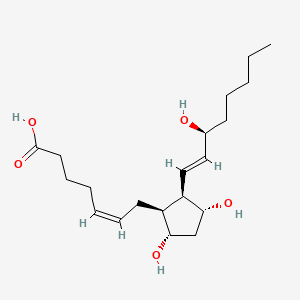
|
15-F2t-IsoP |
15-f2t-isop is a lipid of Fatty Acyls (FA) class. 15-f2t-isop is associated with abnormalities such as Diabetes Mellitus, Acute coronary syndrome, Risk factor, cardiovascular, thrombocytosis and Chronic ischemic heart disease NOS. The involved functions are known as Anabolism, Inflammation, Lipid Peroxidation, Excretory function and Platelet Activation. The associated genes with 15-F2t-IsoP are PTGS2 gene. |
2120 |
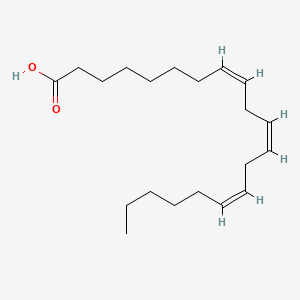
|
bishomo-gamma-linolenic acid |
Bishomo-gamma-linolenic acid is a lipid of Fatty Acyls (FA) class. Bishomo-gamma-linolenic acid is associated with abnormalities such as Diabetes, Obesity, Hypertensive disease, Cirrhosis and Hepatorenal Syndrome. The involved functions are known as Oxidation, Process, Metabolic Inhibition, epoxide hydrolase activity and Signal Transduction Pathways. Bishomo-gamma-linolenic acid often locates in Protoplasm, Cytoplasmic matrix, soluble, Membrane and Tissue membrane. The associated genes with bishomo-gamma-linolenic acid are P4HTM gene, IMPACT gene, arginine methyl ester, CYP gene and PTGS1 gene. The related lipids are Fatty Acids, 17-octadecynoic acid, Lipopolysaccharides, palmitoleic acid and nervonic acid. The related experimental models are Knock-out and Mouse Model. |
2467 |
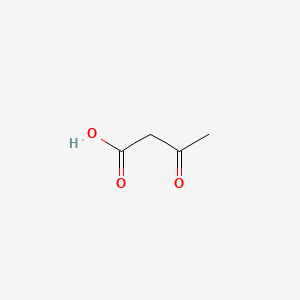
|
Acetoacetic acid |
Acetoacetic acid is a lipid of Fatty Acyls (FA) class.Acetoacetic acid is associated with abnormalities such as Dehydration. The involved functions are known as Biochemical Reaction, intracellular signal transduction, fatty acid elongation, Cytokinesis and Mass-to-Charge Ratio. The associated genes with Acetoacetic acid are CFB gene and mersacidin. Acetoacetic acidis associated with Carbon, Acids, Potassium, Acetoacetic acid and Oximes. The related lipids are Nonesterified Fatty Acids and Stearates. |
2523 |

|
(r)-3-hydroxybutanoic acid |
(r)-3-hydroxybutanoic acid is a lipid of Fatty Acyls (FA) class. |
2710 |
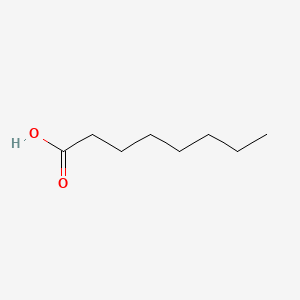
|
octanoic acid |
octanoic acid is a lipid of Fatty Acyls (FA) class. Octanoic acid is associated with abnormalities such as Ischemia, Diabetes Mellitus, Non-Insulin-Dependent, Diabetes, Cardiomyopathies and Obesity. The involved functions are known as Anabolism, 5-(carboxyamino)imidazole ribonucleotide mutase activity, Citric Acid Cycle, Metabolic Inhibition and Excretory function. Octanoic acid often locates in Pore, Protoplasm, Endothelium, Mitochondria and Muscle. The associated genes with octanoic acid are P4HTM gene, CPT1A gene, HADH gene, ACSL1 Gene and CD36 gene. The related lipids are Fatty Acids, Nonesterified Fatty Acids, Oleates, Palmitates and hexanoic acid. |
3349 |

|
6-aminohexanoic acid |
6-aminohexanoic acid is a lipid of Fatty Acyls (FA) class. 6-aminohexanoic acid is associated with abnormalities such as Blood Clot, Myocardial Infarction, Cerebrovascular accident, Renal impairment and Scoliosis, unspecified. The involved functions are known as Fibrinolysis, Agent, Hemorrhage, plasminogen activation and inhibitors. 6-aminohexanoic acid often locates in Chest, Blood, Body tissue, peritoneal and Plasma membrane. The associated genes with 6-aminohexanoic acid are P4HTM gene, BSND gene, MTPN gene, NDUFS4 gene and Homologous Gene. The related lipids are Phosphatidylserines and Butyric Acid. |
3685 |

|
alpha-linolenic acid |
Alpha-linolenic acid is a lipid of Fatty Acyls (FA) class. Alpha-linolenic acid is associated with abnormalities such as Coronary heart disease, abnormal fragmented structure, Arterial thrombosis and Subarachnoid Hemorrhage. The involved functions are known as Anabolism, Signal, Transcription, Genetic, Saturated and Regulation. Alpha-linolenic acid often locates in Blood, Body tissue, Plasma membrane, Hepatic and peroxisome. The associated genes with alpha-linolenic acid are FATE1 gene, volicitin, CYP2U1 gene, CYP1A2 gene and CYP2J2 gene. The related lipids are Fatty Acids, Dietary Fatty Acid, stearidonic acid and Fatty Acids, Nonesterified. |
4231 |
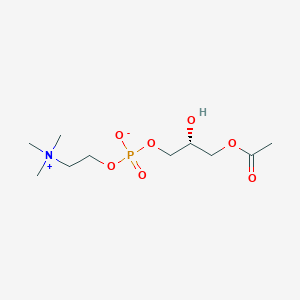
|
Lysophosphatidylcholine |
Lysophosphatidylcholine is a lipid of Glycerophospholipids (GP) class. Lysophosphatidylcholine is associated with abnormalities such as Ischemia, Obesity, Diabetes Mellitus, Non-Insulin-Dependent, Fatty Liver and Atherosclerosis. The involved functions are known as Inflammation, antagonists, Signal Transduction, Signal Pathways and Saturated. Lysophosphatidylcholine often locates in Body tissue, Head, integral to membrane, Membrane and Extracellular. The associated genes with Lysophosphatidylcholine are RHOA gene, Homologous Gene, GPR4 gene, GPR68 gene and TRPV2 gene. The related lipids are Nonesterified Fatty Acids, lysophosphatidylethanolamine, Lysophosphatidylcholines, Phosphatidylserines and 25-hydroxycholesterol. The related experimental models are Knock-out and Disease model. |
4395 |
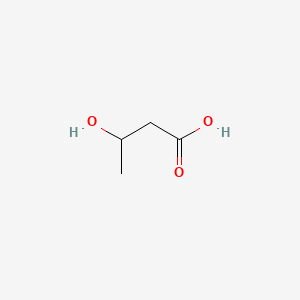
|
3-hydroxybutyric acid |
3-hydroxybutyric acid is a lipid of Fatty Acyls (FA) class. 3-hydroxybutyric acid is associated with abnormalities such as Ketosis. The involved functions are known as fatty acid oxidation, Oxidation, Synthesis, inhibitors and glucose metabolism. 3-hydroxybutyric acid often locates in Blood, Adipose tissue, Protoplasm, Hepatic and Extracellular. The associated genes with 3-hydroxybutyric acid are Genes, Developmental and Oncogene, RET. The related lipids are Fatty Acids, Nonesterified, 6-hydroxyhexanoate, tributyrin, 3-Hydroxyvalerate and Valerates. |
4735 |
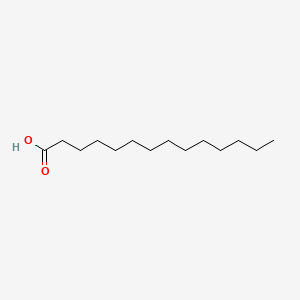
|
Tetradecanoic acid |
Tetradecanoic acid is a lipid of Fatty Acyls (FA) class. Tetradecanoic acid is associated with abnormalities such as Chronic lung disease, Infection, Spastic syndrome, Diabetes and Cardiovascular Diseases. The involved functions are known as Fatty acid biosynthetic process, Anabolism, lung alveolus development, 5-(carboxyamino)imidazole ribonucleotide mutase activity and Homeostasis. Tetradecanoic acid often locates in Structure of parenchyma of lung, Blood, Head, Membrane and Cytoplasmic matrix. The associated genes with Tetradecanoic acid are SLC33A1 gene, SFTPA1 gene, P4HTM gene, Polypeptides and GPR132 gene. The related lipids are Fatty Acids, Nonesterified Fatty Acids, palmitoleic acid, Phosphatidylglycerols and Butanols. |
5058 |

|
quercetin |
quercetin is a lipid of Polyketides (PK) class. Quercetin is associated with abnormalities such as Coronary heart disease, Myocardial Infarction, Cirrhosis, Coronary Arteriosclerosis and Vascular ring. The involved functions are known as Vasodilation, physiological aspects, Fermentation, Process and Ingredient. Quercetin often locates in Arterial system, Endothelium, Skin, Endothelium, Vascular and Tissue specimen. The associated genes with quercetin are P4HTM gene, SULT gene, UGT1A1 gene, ARHGAP26 gene and PLXNB1 gene. The related lipids are blood lipid, Promega, Steroids, Phosphatidylserines and Fatty Acids. The related experimental models are Knock-out, Mouse Model, Xenograft Model, Tissue Model and Cancer Model. |
5377 |

|
stearic acid |
stearic acid is a lipid of Fatty Acyls (FA) class. Stearic acid is associated with abnormalities such as Helminthiasis, Exanthema, Chronic disease, Obesity and Dyslipidemias. The involved functions are known as acyltransferase activity, Mutation, Cell division, cell fate and Fatty Acid Metabolism. Stearic acid often locates in membrane fraction, Mouse Liver, Membrane, Body tissue and Endoplasmic reticulum, membrane. The associated genes with stearic acid are Homologous Gene, ACLY gene, Transgenes, FATE1 gene and Alleles. The related lipids are Lysophospholipids, Stearic acid, Fatty Acids, cis-vaccenic acid and Phosphatidylserines. The related experimental models are Knock-out. |
5692 |

|
Linoleic acid |
Linoleic acid is a lipid of Fatty Acyls (FA) class. Linoleic acid is associated with abnormalities such as Diabetes Mellitus, Non-Insulin-Dependent, Metabolic syndrome, Obesity, Chronic Obstructive Airway Disease and Pneumonia. The involved functions are known as Insulin Resistance, Inflammation, Synthesis, Pathological accumulation of air in tissues and cytokine biosynthesis. The associated genes with Linoleic acid are TNF gene, CCL2 gene and TLR4 gene. The related lipids are palmitoleic acid, nervonic acid and Sphingolipids. |
5699 |

|
EPA |
Epa is a lipid of Fatty Acyls (FA) class. |
5952 |

|
(-)-Epigallocatechin gallate |
(-)-Epigallocatechin gallate is a lipid of Polyketides (PK) class. (-)-epigallocatechin gallate is associated with abnormalities such as IMMUNE SUPPRESSION, Infection, Nodule, Lymphopenia and Tumor Immunity. The involved functions are known as Apoptosis, Cellular Immune Response, Specific immune response, Signal and Infiltration. (-)-epigallocatechin gallate often locates in Immune system, Cytoplasmic Granules, Skin, Protoplasm and Body tissue. The associated genes with (-)-Epigallocatechin gallate are C8orf4 gene, Genes, vpr, MAPK8 gene, P4HTM gene and GAG Gene. The related lipids are Promega, Lipopolysaccharides, Palmitates, Fatty Acids and Sphingolipids. The related experimental models are Mouse Model, Xenograft Model, Transgenic Model, Experimental Autoimmune Encephalomyelitis and Arthritis, Collagen-Induced. |
6551 |

|
Platelet activating factor |
Platelet activating factor is a lipid of Glycerophospholipids (GP) class. Platelet activating factor is associated with abnormalities such as Atherosclerosis, Acute cholecystitis without calculus, Cholecystitis, Colitis and Cholecystitis, Acute. The involved functions are known as Cell Survival, Metabolic Inhibition, lipid oxidation, Apoptosis and Oxidation. Platelet activating factor often locates in soluble, Cellular Membrane, Smooth muscle (tissue), Intima and Tissue specimen. The associated genes with Platelet activating factor are apolipoprotein A-I Milano, Homologous Gene, TSPO gene, HBEGF gene and SLC33A1 gene. The related lipids are Hydroxycholesterols, Liposomes, 25-hydroxycholesterol, Lysophosphatidylcholines and Lipopolysaccharides. The related experimental models are Knock-out, Mouse Model and Transgenic Model. |
7383 |

|
Azithramycine |
Azithramycine is a lipid of Polyketides (PK) class. Azithramycine is associated with abnormalities such as Respiratory Tract Infections, Pneumonia, Lower respiratory tract infection, Infection and Nonspecific urethritis. The involved functions are known as Lysis, Selection, Genetic, Mutation, Relapse and Adaptation. Azithramycine often locates in Blood, Respiratory System, Genitourinary system, Back and Chest. The associated genes with Azithramycine are Genes, rRNA, Genome, RPL22 gene, OPRM1 gene and tryptic soy broth. The related lipids are Liposomes, Phosphatidylserines, Promega, Lipopolysaccharides and Steroids. The related experimental models are Mouse Model, Knock-out and Tissue Model. |
7835 |

|
Lipoic acid |
Lipoic acid is a lipid of Fatty Acyls (FA) class. |
7940 |

|
7-octadecynoic acid |
7-octadecynoic acid is a lipid of Fatty Acyls (FA) class. |
8379 |



















